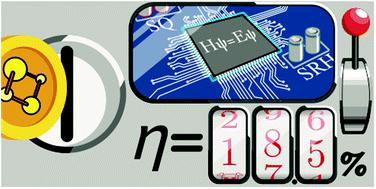当前位置:
X-MOL 学术
›
Energy Environ. Sci.
›
论文详情
Our official English website, www.x-mol.net, welcomes your
feedback! (Note: you will need to create a separate account there.)
Upper limit to the photovoltaic efficiency of imperfect crystals from first principles
Energy & Environmental Science ( IF 32.4 ) Pub Date : 2020-03-09 , DOI: 10.1039/d0ee00291g Sunghyun Kim 1, 2, 3, 4 , José A. Márquez 5, 6, 7, 8 , Thomas Unold 5, 6, 7, 8 , Aron Walsh 1, 2, 3, 4, 9
Energy & Environmental Science ( IF 32.4 ) Pub Date : 2020-03-09 , DOI: 10.1039/d0ee00291g Sunghyun Kim 1, 2, 3, 4 , José A. Márquez 5, 6, 7, 8 , Thomas Unold 5, 6, 7, 8 , Aron Walsh 1, 2, 3, 4, 9
Affiliation

|
The Shockley–Queisser (SQ) limit provides a convenient metric for predicting light-to-electricity conversion efficiency of a solar cell based on the band gap of the light-absorbing layer. In reality, few materials approach this radiative limit. We develop a formalism and computational method to predict the maximum photovoltaic efficiency of imperfect crystals from first principles. The trap-limited conversion efficiency includes equilibrium populations of native defects, their carrier-capture coefficients, and the associated recombination rates. When applied to kesterite solar cells, we reveal an intrinsic limit of 20% for Cu2ZnSnSe4, which falls far below the SQ limit of 32%. The effects of atomic substitution and extrinsic doping are studied, leading to pathways for an enhanced efficiency of 31%. This approach can be applied to support targeted-materials selection for future solar-energy technologies.
中文翻译:

不完全晶体的光伏效率从第一原理的上限
Shockley-Queisser(SQ)限制为根据光吸收层的带隙预测太阳能电池的光电转换效率提供了一种方便的度量标准。实际上,几乎没有材料能达到此辐射极限。我们开发出一种形式主义和计算方法,以根据第一原理预测不完全晶体的最大光伏效率。陷阱限制的转换效率包括天然缺陷的平衡种群,它们的载流子捕获系数以及相关的重组率。当应用于星状太阳能电池时,我们发现Cu 2 ZnSnSe 4的固有极限为20%,远远低于SQ限制32%。研究了原子取代和非本征掺杂的影响,从而为提高效率31%提供了途径。该方法可用于支持未来太阳能技术的目标材料选择。
更新日期:2020-03-09
中文翻译:

不完全晶体的光伏效率从第一原理的上限
Shockley-Queisser(SQ)限制为根据光吸收层的带隙预测太阳能电池的光电转换效率提供了一种方便的度量标准。实际上,几乎没有材料能达到此辐射极限。我们开发出一种形式主义和计算方法,以根据第一原理预测不完全晶体的最大光伏效率。陷阱限制的转换效率包括天然缺陷的平衡种群,它们的载流子捕获系数以及相关的重组率。当应用于星状太阳能电池时,我们发现Cu 2 ZnSnSe 4的固有极限为20%,远远低于SQ限制32%。研究了原子取代和非本征掺杂的影响,从而为提高效率31%提供了途径。该方法可用于支持未来太阳能技术的目标材料选择。











































 京公网安备 11010802027423号
京公网安备 11010802027423号